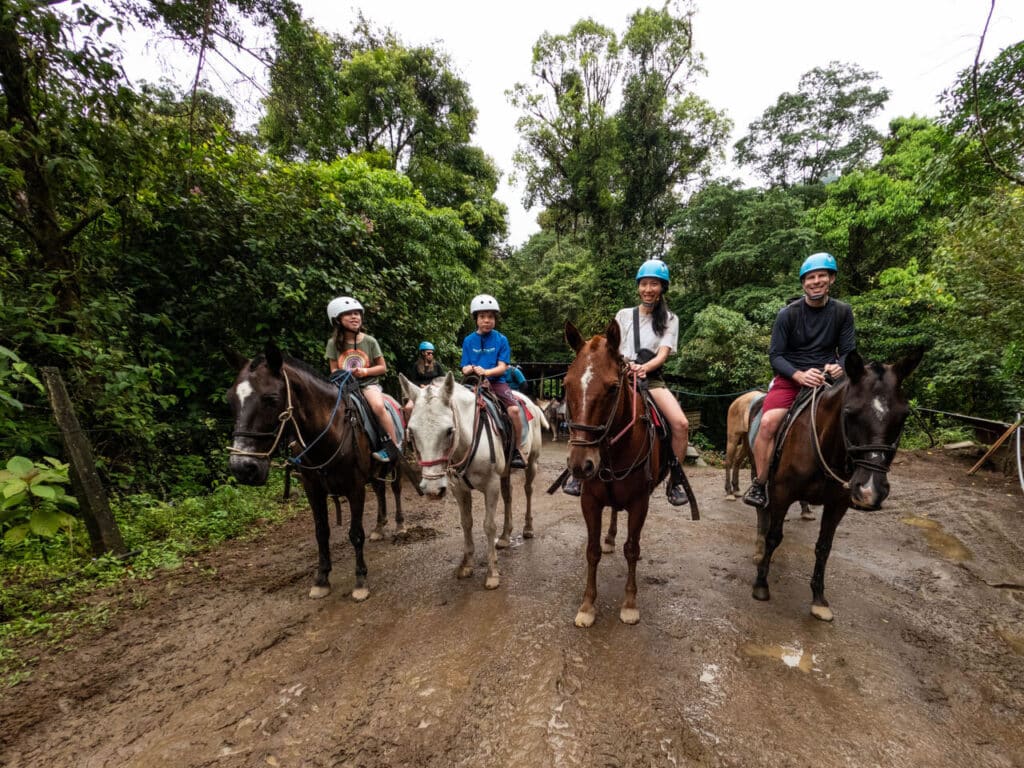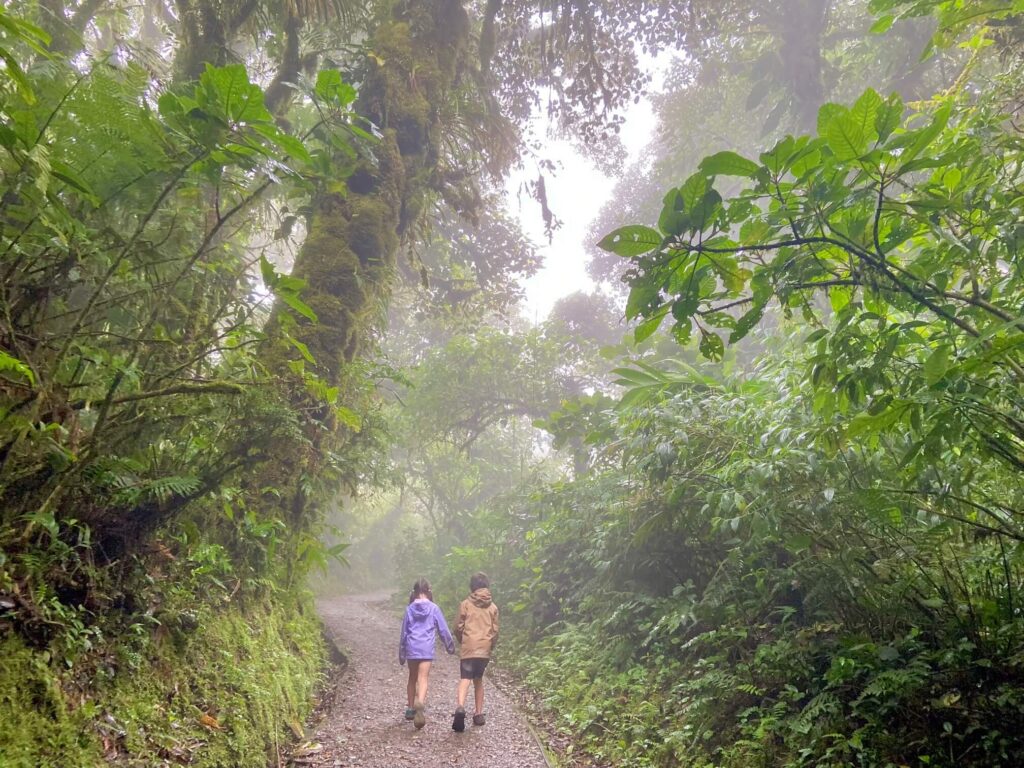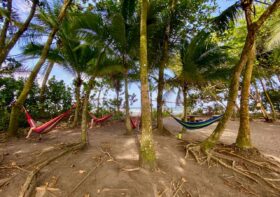Packing guide: Costa Rica dry season

We naively thought packing for Costa Rica would be a cinch. Space-saving hot weather clothes, lots of swimwear – how hard could it be?
Very hard, as it turns out.
While maybe not as challenging as stuffing 2 weeks worth of clothes for Iceland into our carry-ons, packing for Costa Rica comes with a number of considerations. For starters, “dry season” does not actually mean “dry”. You need to prepare for rainy days and muddy hikes. Hot weather is not guaranteed – high altitude places like Monteverde may actually be quite chilly, especially at night. And finally, perhaps the most challenging, packing for what you plan to do. And in Costa Rica, there is *a lot* to do.
This resulted in a lot of google searching for things like, “will my feet get eaten by ants if I wear sandals on my hike?” and “will I regret wearing shorts while zip-lining”?
This post is less of a “list”, and more of a guide. What you pack depends of course on what you will be doing, and how long you will be traveling. Hopefully, our packing tips will help take the stress out of the planning, and give you a sense of what you need for travel to Costa Rica during dry season.
Essential packing considerations

Packing light/carry-on only
To be honest, I think we’ve gotten to the point in our travels where stuffing our entire trip into a carry-on for each of us is more a matter of pride than utility. 😛
However, we do like the convenience for flying days. Traveling with carry-on minimizes lost luggages and delays with checking in and collecting bags.
For Costa Rica, we rented a car and changed locations every 3 days or so, so it was very helpful having portable luggage that even the kids could manage. For our compact 4×4, 4 carry-on suitcases and a backpack or two fit perfectly into our trunk.
But the most helpful place to pack light is if you are planning to travel to Tortuguero. Tortuguero is a small town on the Atlantic coast that cannot be accessed by car. You will most likely be taking a boat (a water-taxi). These boats are small, as they wind through rainforest canals, and the boats fill up. Larger pieces of luggage get very unwieldy very fast. Furthermore, as there are no cars in Tortuguero, you will need to lug your luggage around for your entire stay.
Plan on more than one outfit per day
There were many days we came back from a hike or activity wet and/or muddy. At the very least, expect to be sweaty. Make sure you have enough changes of clothes to get you through your vacation or to laundry day. Plan to do laundry if you will be traveling for more than 1 week – we usually find it difficult to fit more than that into a carry-on.
Shoes for Costa Rica dry season
There is A LOT of advice on what kind of footwear you need in Costa Rica. Some blogs will suggest hiking shoes or boots, or even rubber boots in some parks. (But most places that require rubber boots are for wet season, and you can usually rent these on site.) This was probably our biggest *in*decision, as we obviously wanted to be prepared, but did not want to overpack heavy footwear.
Overall, we recommend three pairs of shoes:
Shoes for hiking and adventure
You need 1 pair of good walking shoes, sneakers, hiking shoes or hiking sandals. Bonus of they are waterproof. Unless you are really planning to go off the beaten path, you definitely do *not* need hiking boots.
Our top recommendation is a sturdy pair of hiking sandals with mesh. Our kids each had a pair of Keen H2SHOs. (Sadly, I think they have been discontinued.) These were the *perfect* Costa Rica adventure shoes. They had grippy soles for slippery terrain. They could get wet, so the kids were splashing across streams and waterfalls without a care in the world. The mesh kept out any bugs and annoying debris from getting into the shoes. If you are in sandals, you do not need to worry about packing extra socks.
Us adults did not have shoes like these, and we did not want to buy new shoes for our trip. We ended up bringing 2 pairs of shoes – our Keen hiking sandals, and an old pair of sneakers, fully prepared to dispose of them at the end of the trip. We brought the sneakers because we read some parks do not allow open shoes. (And subliminally we *were* worried about biting ants or – yikes! – scorpions.)
We wore our hiking sandals for most of our adventures, including hikes, hanging-bridges, zip-lining, horseback riding. They are grippy, and the closed toed design offers a lot of protection. We did *not* have any issues with bugs getting into them, and liked that they could get comfortably wet. The only places we wore sneakers was on our night tour, and our guided hike into Tortuguero National Park. (We were told this was mandatory.)
We do feel the hiking sandals won out because everything is wet, even during dry season. However, it’s most ideal to have some protection for the open bits, in case it’s very muddy or there are poisonous critters around. This is especially true for kids, who like to get into stuff. 😛 (If you cannot find a pair of mesh sandals for kids, we recommend sneakers.) If you bring sneakers or shoes, try to find ones that are quick-dry. Otherwise, expect to walk around in wet socks and having to dry out your shoes after most hikes.
Casual sandals
Something for walking around town, and does double duty for the beach.
We recommend something a little more substantial than flip-flops. You will likely be spending a good amount of your none-hiking time in these, while your hiking sandals/shoes dry out. 😛 (Lil S did sneak in an extra pair of flip flops, but her shoes are tiny.)
Our kids had a pair of Native shoes, which are kind of like a sportier version of Crocs. They have pretty grippy soles and are comfortable for walking. Our kids wear these as their “regular shoes” in the summer, so actually wore these as their “main” shoes in Costa Rica.
Us adults had less cool sandals. 😛 (Birkenstocks, slides, etc.)
Water shoes
These are useful if you are planning to do water activities. Our water shoes came in most handy around Arenal. We wore them to our day at the Tabacon hot springs resort (lots of pebbly surfaces), and at places like the El Salto Rope Swing. These flatten and are easy to pack, so I would try to include a pair of you can.


Clothes for hiking
For hiking, nature walks, and guided animal tours. Have you even been to Costa Rica if you haven’t at least strolled through a rainforest?
We read some articles about needing serious hiking gear, including hiking pants and long sleeve shirts to protect against the elements. We went on a lot of tours and hikes, and again, unless you plan on venturing deep into the jungle, you can wear casual activewear. The trails are wide enough you won’t be brushing against bush on your hikes.
(We’re not even going to get into packing for multi-day nature hikes, eg. into Corcovado National Park – if you are doing this, we imagine you know what you’re doing. :P)
T-shirts and shorts are fine, for the most part. On a rainy hike, it may be preferable to wear shorts, instead of slogging around in wet pants. Bonus if your gear is water resistant or quick dry.
Long pants
We do recommend a pair of long pants (which you can wear on the plane). We wore pants on our night hike, worried we would run into something (or some creature) in the dark. Sometimes the higher elevations can get quite cool in the early mornings and evenings.
Thin rain jacket
This is a MUST. Even during dry season, it will rain on and off throughout the day. Packable raincoats are handy as you can stuff them in your backpack during a hike.
Clothes for activities
Zip-lining
Honestly, casual clothes are fine! And unless your shorts are *very* short, you don’t need to worry about the harness chafing any sensitive body parts. 😛
You *can* zip-line in the rain. If it is raining, wear quick dry clothes, and your raincoat. Most zip-lining tours will also have rain jackets or ponchos for rent if you do not have your own.
Closed shoes are *not* needed (we wore our Keen sandals and they were fine), but closed toed shoes are recommended.
Horseback riding
Again, casual clothes are fine. And closed toed footwear.
Hot springs
Regular swimwear. There are no issues with the heat ruining fabric.
Bring your watershoes as some hot springs have sandy and rocky bottoms.
River rafting
Swimwear is fine, but we recommend longer bottoms (shorts and not bikinis or speedos…) There is quite a bit of chafing that may happen between your butt and the seat and it’s better to be protected! Consider a rash guard or quick dry shirt for added protection, both from sun and from the elements.
We recommend watershoes or hiking sandals for rafting. This is in case you fall from the raft and need to assume the “white water swimming” stance – which is floating on your back with your feet downstream for protection.
No hats or sunglasses if you hope to still have them by the end of your tour!
Canyoning or waterfall repelling
Active clothes like you would wear on a hike, preferably quick dry.
Shoes – we recommend hiking sandals or alternatively, water shoes with a grippy sole.
ATVing
Casual activewear and closed toe shoes or sandals.
(For other Costa Rica activities… you’re on your own. 😉 But whatever tour you end up booking, they will usually tell you the appropriate clothes and footwear on their website, in their booking email, or you should inquire with them directly when booking.)


Packing for the beach
Now this is where the space-saving hot weather clothes and lots of swimwear come in. 😉
In addition to swimwear and coverups, we also recommend a rash guard with long sleeves. Consider wetsuits for infants and young children. The Costa Rican sun is *strong*, and we found you could only really do 2-3 hours in the sun even with sunscreen. Lil S spent 3 of her 4 beach days in her long sleeve rash guard after getting a little too much sun on the first day.
Don’t forget reef-safe sunscreen, a hat, and sunglasses.
You will also need a packable travel towel, for the number of public beaches you’ll come across and want to enjoy.
Snorkel gear can come in handy particularly along the pacific coast, but unless you plan to do a lot of it, is not worth taking up your precious cargo space. In most places you can rent equipment on the beach, and gear will be included on any tours you take. Goggles would be useful though, and would work in lieu of a snorkel mask in a pinch.
Packing for casual days
Casual wear is fine for your regular stroll around town or to grab food at a restaurant. We didn’t see anyone dressing up anywhere we went in Costa Rica. Most travellers are coming for adventure will be dressing for the activities above.
With that being said, a few blouses or dresses or button down shirts will never hurt if you want to look nice for dinner!
Packing for car/travel days
Most destinations in Costa Rica are about 3 hours apart, so you never really have to travel the entire day to get between locations.
Wear comfortable casual clothes (how many times in this post have I said “casual clothes”? :P)
If traveling with kids, be sure to download audiobooks and playlists for the ride, and of course, whatever regularly entertains them in the car.
We also bring snacks *from home* – usually granola bars, nuts, and meat jerky. Yes, we do pack snacks into our not-very-expendable luggage. Even if we are buying groceries and eating out, you inevitably won’t be able to find that store or restaurant when you kid is the hungriest. This is especially true of travel days, when you don’t know the area and don’t know what you’ll be passing through. We also pack local goodies to take along with us, including fresh fruit. Many car rental agencies will include an ice box (a cooler) free of charge.
Consider bringer ginger candies or ginger chews for those twisty, vestibular-wrecking Costa Rican roads. Anti-nausea or anti-seasickness medication may be needed if you are prone to car sickness.
Packing a kids activity bag
Costa Rica is the *easiest place* to entertain kids. So much green space and so much wildlife. We have a post on making the most of it with pocket nature guides, binoculars, and giving each kid their own camera.
Packing photo gear
This was actually quite funny – we traveled with 4 different types of cameras!
Phone
In most cases, your phone will work just fine. (And in some cases, such as when we went on our bioluminescence tour, the phone worked *better* than our fancier cameras.)
Adventure camera/GoPro
We also recommend a GoPro or equivalent type action camera. We were able to capture our entire zip-lining adventure with our GoPro. The company we used, Sky Adventures, even had helmets that had the GoPro attachment to them, so you can use your own GoPro. Action cameras are also extremely handy as they can get wet. We used it for exploring waterfalls, hot springs, and at the beach. We also used the GoPro quite a bit on hikes, as it is compact and easy to pack, and takes great wide-angle shots and videos.
Camera with optical zoom
Our next recommended camera is a digital camera with the longest zoom you can find. We used an old camera we first bought for our Tanzanian safari many years ago. It’s not the best quality camera, but it can spot and capture animals from 1 km away! Our kids also enjoyed taking pictures with this, and because it is older, we did not have to be on their cases to handle with care. 😛
DSLR
We also brought our large DSLR camera to Costa Rica. (Our go to travel lens is a 24-70mm. Daniel also sometimes brings 50mm and 135mm prime lens.) This camera is still a staple in our travels. Although it is bulky, we still find the quality to be unbeatable, especially when printing or blowing up the photos. Keep in mind you do have to haul it around if you bring it for the day, and you do not want to leave any valuables in the car. We used our DSLR on some easy hikes, and to capture sunsets.
Accessories
Bring a small tripod. We have one that comes with our GoPro which also doubles as a selfie-stick. For our DSLR, we use the Gorillapod. If you do not have an adventure camera, bring a waterproof case for your phone.

Packing travel essentials
Don’t forget the essentials!
- Passport
- Hiking daypack
- reusable water bottle
- Bug spray
- Toiletries and feminine hygiene products
- first-aid bag
- Electronic charging cables, and extra battery pack in case you need to recharge your devices on long hikes
Money
Costa Rica accepts Costa Rican colones as well as US dollar. It is always good to pay if colones if possible, as many spots – especially smaller, less touristy spots – will mark up the price in US dollars.
Most tourist locations will accept major credit cards. BUT be careful of possible high credit card fees – we were quoted 8% at our hotel in Tortuguero.
There are banks and ATMs to withdraw colones. (There are NO ATMs in Tortuguero. Bring cash!) We recommend bringing at least several days worth of colones with you or exchange at the airport.
Cell phone
Costa Rica supports eSIMs, and this is the easiest way to ensure you can stay connected. You can purchase your eSIM plan from Gigsky, Holafly, aloSIM, or Nomad.



